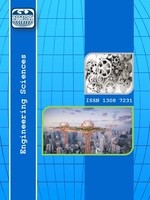ÇELİK VE POLİPROPİLEN LİFLERİN GELENEKSEL VE YÜKSEK PERFORMANSLI BETONLARDA KIRILMA VE ÇATLAK GELİŞİMİNE ETKİSİ
Günümüzde geleneksel betonlar kadar yüksek performanslı betonlar da kolaylıkla üretilebilmektedir. Betonların basınç dayanımının yüksek olması kadar, belli oranda sünek davranış göstermesi de istenmektedir. Bu amaçla, son yıllarda, sünekliği sağlayabilmek için üretimlerinde betonu liflerle takviye etmeye başlamışlar ve bu konuda da bir çok araştırma yapmışlardır. Bu liflerin başında çelik lifler gelmektedir. Bu çalışmada çelik ve polipropilen lif katkılı geleneksel ve yüksek dayanımlı betonlar üretilerek, bu betonların merkezi basınç, yarmada çekme dayanımları araştırılarak, çentikli numunelerde betonların kırılma ve çatlak gelişimleri incelenmiştir.
Anahtar Kelimeler:
Çelik ve Polipropilen Lifler, Geleneksel Beton, Yüksek Dayanımlı Beton, Kırılma, Çatlak Gelişimi,
THE EFFECT OF FRACTURE AND CRACK GROWTH OF STEEL AND POLYPROPYLENE FIBERS IN THE ORDINARY AND HIGH STRENGTH CONCRETE
Today, high performance concrete can be produced as easily as normal strength concrete. Concretes are expected to have ductile behavior and have compressive strength, as well. In the recent years, in order to have ductile behavior, researchers have started to strengthen concrete using fibers and have done lots of researches. In this study, normal and high strength concrete with steel and polypropylene fiber are produced, the compressive strength and the tensile strength in split of these concrete is investigated and the fracture energy and crack distribution of notching samples are examined.
Keywords:
Steel and Polypropylene Piber, Ordinary Concrete, High Strength Concrete, Fracture, Crack Developmants, ,
___
- Eser, O.F. and Tasdemir, M.A., (2002). Application of fracture mechanics models to notched concrete disc specimens, ITU Journal/d cilt:1 sayı:2, pp. 63-74.
- Shah, S.P. and Tasdemir, M.A., (1994). Role of Fracture Mechanics in Concrete Technology, Advances in concrete Technology, Ed. V. M. Malhatra, CANNET, Second Edition, pp.16120
- Shah, S.P. and Mc Grarry, P.J., (1971). Griffith Fracture Criterion and Concrete. Journal of Engineering Mechanics, Division-ASCE, 97, Nb, EMb, pp.1663-1676.
- Weertman, J., (1978). Fracture Mechanics: A Unified View for Griffith-Irwin-Orowan Cracks. Acta Metallurgica, 26 (11), pp. 1731-1738.
- Kaplan, M.F., (1961). Crack Propagation and the Fracture of Concrete. Journal of ACI, Vol 58, pp.591-610.
- Kesler, C.E., Naus, D.J., and Lott, J.L., (1971).Fracture Mechanics its applicability to concrete. The Society of Materials Science, Vol 4, pp.113-134.
- Strange, P.C. and Bryant, A.H., (1979). Experimental Tests on Concrete Fracture.Proc.ASCE 105, No. EM2, pp.337-342. Strange, P.C. and Bryant, A.H. (1979). The role of aggregate size in the fracture of concrete. Journal of Materials Science, 14, pp.1863-1868.
- Hillerborg, A., Modeer, M., and Peterson, P.E., (1976). Analysis of Crack Formation and Crack Growth in Concrete by Means of Fracture Mechanics and Finite Elements. Cement and Concrete Research, 6, pp.773-782.
- Bazant, Z.P. and Kazemi, M.T., (1990). Determination of Fracture Energy, Process Zone Lenght, and Brittleness Number from Size Effect, with Application Rock and Concrete. International Journal of Fracture, 44, pp.111-131.
- Jeng, Y.S. and Shah, S.P.,(1985). Two Parameter Fracture Model for Concrete. Journal of Engineering Mechanics, ASCE, 4, pp.1227-1241.
- Hillerborg, A., (1985). The Theoretical Basis of a Method to Determine the Fracture Energy (G F ) of Concrete. Materials and Structures, 18, 106, pp. 291-296.
- Hallathambi, P. and Karihaloo, B.L., (1986). Determination of Specimen-Size Independent Fracture Toughness of Plain Concrete. Magazine of Concrete Research, 38, 135, pp.67-76.
- Swartz, S.E. and Refai, T.M.E., (1988). Influence of Size Effects on Opening Mode Fracture Parameters for Precraked Concrete Beams in Bending’’, Fracture of Concrete and Rock, pp.243-254. Springer-Verlag, New York.
- Tang, T., Shah, S.P., and Ouyang, C., (1992). Fracture Mechanics and Size Effect of Concrete in Tension. Journal of Structural Engineering, ASCE, 118, 11, pp. 3169-3185.
- Tang, T., (1994). Effects of Load-Distributed Width on Split Tension of Unnotched and Notched Cylindrical Specimens. Journal of Testing and Evolution, 22, 5, pp.401-409.
- Tang, T., Ouyang, C., and Shah, S.P., (1992). A Simple Method for Determining Material Fracture Parameters from Peak Loads, ACI Materials Journal, 93, 2 pp.147-157.
- Yang, S., Tang, T., Zollinger, D.G., and Gurjar, A., (1997). Splitting Tension Tests to Determine Concrete Fracture Parameters by Peak-Load Method. Advance Cement Based Materials, 5, pp. 8-28.
- Karataş, M., (2009). Kendiliğinden Yerleşen Betonda Basınç Dayanımı ile Çekme Dayanımı ve E-Modülü İlişkisi. E-Journal of New World Sciences Academy 4(1), 258-270. (NWSA,DOI:URL:http://dv.doi.org/10.12739 / )
- Başlangıç: 2009
- Yayıncı: E-Journal of New World Sciences Academy
